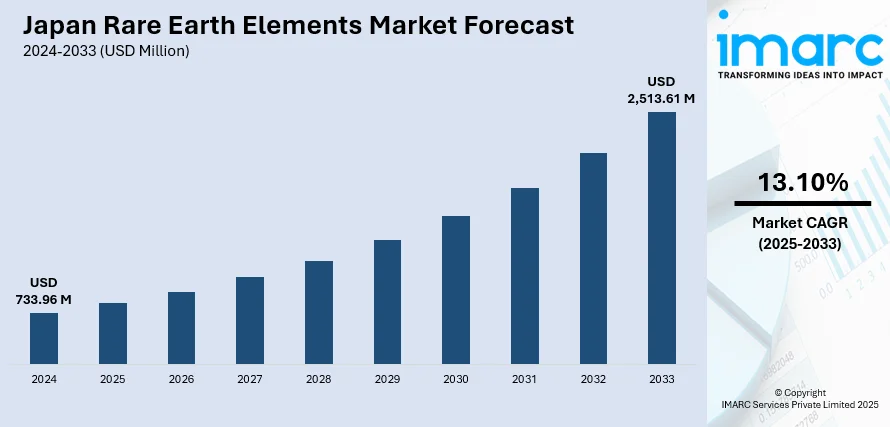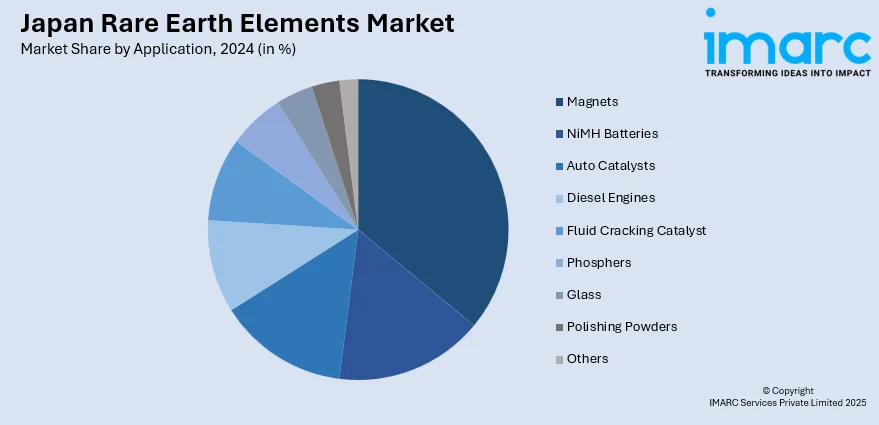
Japan Rare Earth Elements Market Size, Share, Trends and Forecast by Application and Region, 2025-2033
Japan Rare Earth Elements Market Overview:
The Japan rare earth elements market size reached USD 733.96 Million in 2024. Looking forward, IMARC Group expects the market to reach USD 2,513.61 Million by 2033, exhibiting a growth rate (CAGR) of 13.10% during 2025-2033. Japan’s rare earth elements market is being driven by its high-tech manufacturing demands, strategic efforts to reduce import dependence, government-backed resource security initiatives, rising electric vehicle production, and investments in deep-sea mining and recycling technologies, all aimed at securing a stable and self-reliant supply of critical minerals for economic and technological resilience.
|
Report Attribute
|
Key Statistics
|
|---|---|
|
Base Year
|
2024 |
|
Forecast Years
|
2025-2033
|
|
Historical Years
|
2019-2024
|
| Market Size in 2024 | USD 733.96 Million |
| Market Forecast in 2033 | USD 2,513.61 Million |
| Market Growth Rate 2025-2033 | 13.10% |
Japan Rare Earth Elements Market Trends:
Technological Dependence on Rare Earth Elements in High-Tech Industries
One of the main drivers of Japan's rare earth elements market is its heavy dependence on these elements in high-tech manufacturing industries. Japan is a world leader in electronics, robotics, automotive (specifically electric vehicles or EVs), renewable energy, and precision machinery — all of which need specific REEs for performance and functionality. For example, neodymium and dysprosium are crucial in the manufacture of high-performance magnets employed in EV motors, wind turbines, and hard disk drives. Europium and yttrium are equally crucial in the manufacture of phosphors for LCDs and LEDs. Since Japan lacks significant domestic reserves of these elements, the necessity to ensure a stable and unbroken supply chain has become paramount. Local firms such as Hitachi, Panasonic, and Toyota have invested significantly in R&D and supply chain refinement to guarantee availability of REE. This industrial reliance translates to increasing domestic demand, not only for finished REEs but also for upstream integration, such as recycling and refining technologies. In addition, the Japanese government has classified rare earths as strategic resources, further affirming their position in ensuring the nation's technological competitiveness in the world market, and hence hastening the development of the domestic REE industry.

Geopolitical Diversification of Supply Chains and Resource Security
Another driver of Japan's rare earth elements market is its strategic push towards geopolitical diversification and resource security. Traditionally, when it comes to REEs, Japan has been over-dependent on China, which dominates much of global REE production. But in 2010, a diplomatic row over a territorial dispute over the Senkaku Islands with China resulted in a temporary rare earth export embargo against Japan, highlighting the vulnerability of such a concentrated supply chain. That event turned the tide and led the Japanese government and private sector to significantly re-evaluate their sourcing approaches. Japan, in turn, started making strategic alliances with nations such as Australia, Vietnam, and India to obtain alternative REE sources. For example, Sojitz Corporation and Japan Oil, Gas and Metals National Corporation (JOGMEC) invested in overseas mining projects such as the Mount Weld mine in Australia. Japan has also invested in cutting-edge exploration activities in Southeast Asia and Africa. In addition to ensuring Japan a more stable supply chain, these activities lower the geopolitical risks involved in relying on a single supplier.
Japan Rare Earth Elements Market Segmentation:
IMARC Group provides an analysis of the key trends in each segment of the market, along with forecasts at the region/country level for 2025-2033. Our report has categorized the market based on application.
Application Insights:

- Magnets
- NiMH Batteries
- Auto Catalysts
- Diesel Engines
- Fluid Cracking Catalyst
- Phosphers
- Glass
- Polishing Powders
- Others
The report has provided a detailed breakup and analysis of the market based on the application. This includes magnets, NiMH batteries, auto catalysts, diesel engines, fluid cracking catalyst, phosphers, glass, polishing powders, and others.
Regional Insights:
- Kanto Region
- Kansai/Kinki Region
- Central/Chubu Region
- Kyushu-Okinawa Region
- Tohoku Region
- Chugoku Region
- Hokkaido Region
- Shikoku Region
The report has also provided a comprehensive analysis of all the major regional markets, which include Kanto Region, Kansai/Kinki Region, Central/Chubu Region, Kyushu-Okinawa Region, Tohoku Region, Chugoku Region, Hokkaido Region, and Shikoku Region.
Competitive Landscape:
The market research report has also provided a comprehensive analysis of the competitive landscape. Competitive analysis such as market structure, key player positioning, top winning strategies, competitive dashboard, and company evaluation quadrant has been covered in the report. Also, detailed profiles of all major companies have been provided.
Japan Rare Earth Elements Market News:
- November 2024: Japanese researchers discovered approximately 230 million tons of manganese nodules rich in cobalt and nickel on the seabed near Minamitori Island. This deposit can potentially fulfill Japan's cobalt needs for 75 years and nickel needs for 11 years, significantly reducing reliance on imports. The discovery is expected to bolster Japan's rare earth elements market by enhancing domestic supply for high-tech industries and strengthening economic security.
- July 2024: Japan expanded its continental shelf eastward, incorporating approximately 120,000 square kilometers of the Ogasawara Plateau into its jurisdiction. This move allows Japan to exercise sovereign rights over the exploration and development of natural resources, including cobalt-rich crusts containing rare metals essential for electric vehicle batteries. The expansion aims to enhance Japan's resource security and reduce reliance on imports, particularly from dominant suppliers like China.
Japan Rare Earth Elements Market Report Coverage:
| Report Features | Details |
|---|---|
| Base Year of the Analysis | 2024 |
| Historical Period | 2019-2024 |
| Forecast Period | 2025-2033 |
| Units | Million USD |
| Scope of the Report | Exploration of Historical Trends and Market Outlook, Industry Catalysts and Challenges, Segment-Wise Historical and Future Market Assessment:
|
| Applications Covered | Magnets, NiMH Batteries, Auto Catalysts, Diesel Engines, Fluid Cracking Catalyst, Phosphers, Glass, Polishing Powders, Others |
| Regions Covered | Kanto Region, Kansai/Kinki Region, Central/Chubu Region, Kyushu-Okinawa Region, Tohoku Region, Chugoku Region, Hokkaido Region, Shikoku Region |
| Customization Scope | 10% Free Customization |
| Post-Sale Analyst Support | 10-12 Weeks |
| Delivery Format | PDF and Excel through Email (We can also provide the editable version of the report in PPT/Word format on special request) |
Key Questions Answered in This Report:
- How has the Japan rare earth elements market performed so far and how will it perform in the coming years?
- What is the breakup of the Japan rare earth elements market on the basis of application?
- What are the various stages in the value chain of the Japan rare earth elements market?
- What are the key driving factors and challenges in the Japan rare earth elements market?
- What is the structure of the Japan rare earth elements market and who are the key players?
- What is the degree of competition in the Japan rare earth elements market?
Key Benefits for Stakeholders:
- IMARC’s industry report offers a comprehensive quantitative analysis of various market segments, historical and current market trends, market forecasts, and dynamics of the Japan rare earth elements market from 2019-2033.
- The research report provides the latest information on the market drivers, challenges, and opportunities in the Japan rare earth elements market.
- Porter's five forces analysis assist stakeholders in assessing the impact of new entrants, competitive rivalry, supplier power, buyer power, and the threat of substitution. It helps stakeholders to analyze the level of competition within the Japan rare earth elements industry and its attractiveness.
- Competitive landscape allows stakeholders to understand their competitive environment and provides an insight into the current positions of key players in the market.
Need more help?
- Speak to our experienced analysts for insights on the current market scenarios.
- Include additional segments and countries to customize the report as per your requirement.
- Gain an unparalleled competitive advantage in your domain by understanding how to utilize the report and positively impacting your operations and revenue.
- For further assistance, please connect with our analysts.
 Request Customization
Request Customization
 Speak to an Analyst
Speak to an Analyst
 Request Brochure
Request Brochure
 Inquire Before Buying
Inquire Before Buying




.webp)




.webp)












